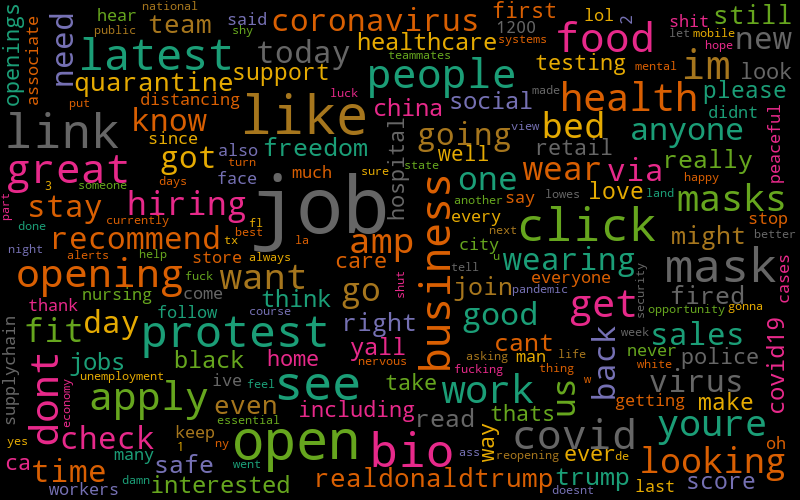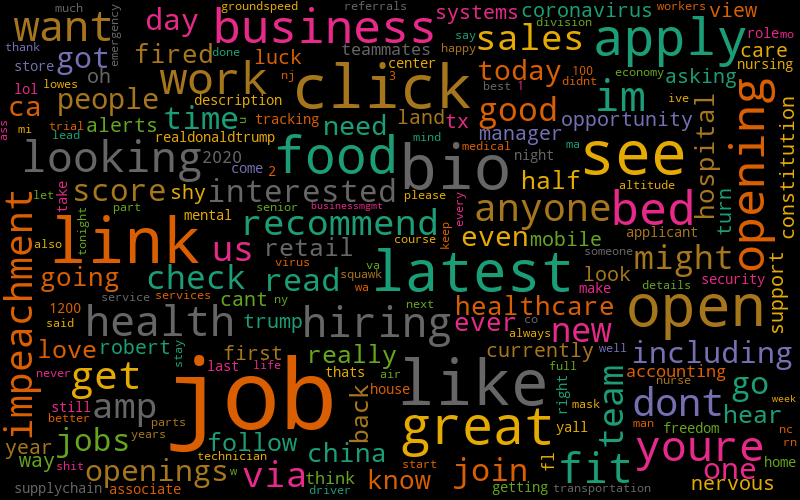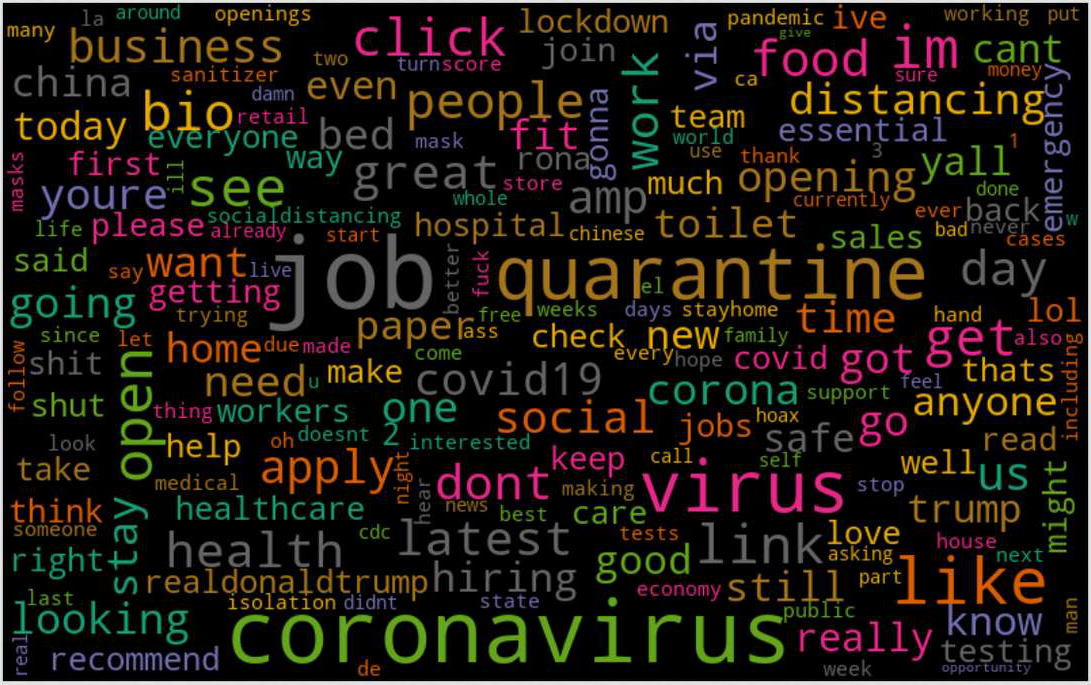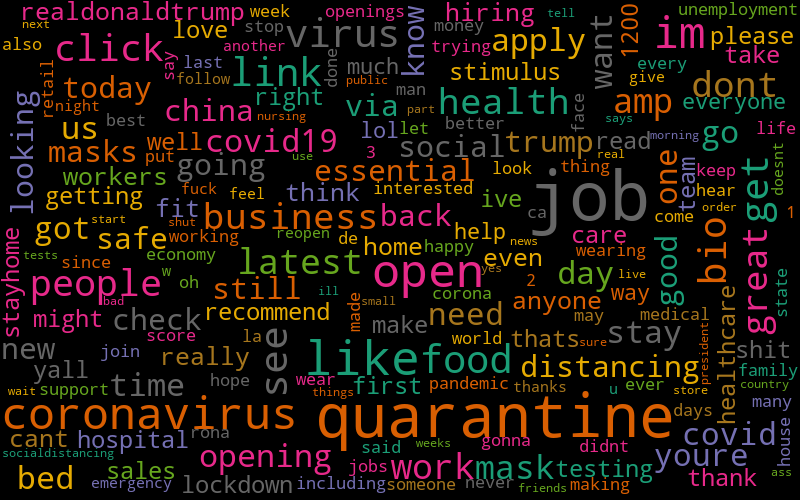A sixth month overview of the geolocated Twittersphere surrounding the COVID-19 pandemic

Image depicts word cloud results of geolocated Twitter data on COVID-19 pandemic in June 2020. Using approximately 245 keywords, these findings were identified by the DS3 team during data collection.
Individuals across the globe have taken to social media to cope and express concerns or dismay over the coronavirus pandemic. The coronavirus has caused detrimental, life-threatening circumstances, and deaths globally. It has disrupted lives, the economy, the government, family institutions and the like from the start of the pandemic in January and its detrimental consequences continue into the present. But, have you ever wondered… what exactly are the most pressing topics surrounding this pandemic? And, how are they discussed in social media?
In this blog, we address these questions by collecting geolocated Twitter data from January 2020 to June 2020 using approximately 245 keywords which included both words and trending hashtags that were identified by the Data Science for Social Sciences (DS3) team during the six months of data collection. These keywords and hashtags included words to describe the virus, such as COVID-19, SARS-CoV-2, Corona, Corona virus, coronavirus. We also used words to describe forms of protection against the virus, such as quarantine, mentions of stay at home orders, masks, and hand sanitizer. Lastly, we also included words like toilet paper and food to reflect other unexpected challenging aspects that have resulted from the state of anxiety, panic, and fear leading to public behavioral responses associated with this pandemic. Finally, we also included trending hashtags such as #COVID19, #COVID, #19, #Corona, #WuhanVirus, #Pandemic, #Virus, #ChineseVirus, #CoronaHoax #Chinese, #Virus, #Quarantine, #BatVirus, #SocialDistancing, #coronapocalypse, and #coronageddon to capture the array of trending topics as occurring in social media during the pandemic. If any of the 245 keywords were mentioned, the tweet content was pulled from our Human Sensor Project, which has collected geolocated data from Twitter since 2015 and stored into a database for further analysis.
We opted to depict these millions of tweets in word clouds. Word clouds are a visual way of depicting an actual count of the number of times that certain words are mentioned within a dataset. Here, we depict which words are the most prevalent and which words are discussed in greater to fewer frequency over the sixth month period of data collection.
The results are in and they’re quite relatable and reflective of our shared consciousness regarding this pandemic. We are all experiencing the effects of this pandemic and this is notable in the word clouds presented throughout this blog.
As you can see, “jobs,” and job-related content appear across the six-month time period. The keyword, “job” also stays relatively the same size in measure as depicted across the word clouds. However, by March and throughout May, “quarantine” and “coronavirus” along with words like “distancing,” also become prevalent. By June, the discussion shifted in prevalence toward opening the economy and businesses.
We are all experiencing the effects of this pandemic and this is notable in the word clouds presented throughout this blog.
January
When we look specifically into the month of January, words like “job,” “business,” “work,” “link,” “click”, “hiring,” “fired,” “food,” “hospital,” “bed,” and “health” were already trending. By January 1, the World Health Organization (WHO) began to deal with the cluster of cases of pneumonia reported in Wuhan. WHO then began disseminating knowledge to the public through releasing news and technical guidance on the novel virus. Thailand then experienced the first case recorded outside of China (January 13, 2020). Continued investigation and analysis of the virus pressed onward. By January 30, 2020 the virus was considered a Public Health Emergency of International Concern (PHEIC).

Image depicts word cloud results of geolocated Twitter data on COVID-19 pandemic in January 2020. Using approximately 245 keywords, these findings were identified by the DS3 team during data collection.
February
By February 3, 2020, WHO released a Strategic and Preparedness and Response Plan to protect states with weaker health systems. WHO also held the Research and Innovation Forum where 400 experts attended from the 11th – 12th of February. As depicted in the word cloud for February, “job,” “business,” “link,” “click,” “hiring,” “food,” “hospital” and “health” remain prevalent as new words increased in prevalence, such as “virus,” “coronavirus,” and “healthcare.”
New words increased in prevalence, such as “virus,” “coronavirus,” and “healthcare.”

Image depicts word cloud results of geolocated Twitter data on COVID-19 pandemic in February 2020. Using approximately 245 keywords, these findings were identified by the DS3 team during data collection.
March
Early March marked the time of alarming and increasing cases of COVID-19 with accompanied inaction for many places. Keywords such as “job,” “click,” and “food” remained prevalent. However, keywords such as “quarantine,” “coronavirus,” “virus,” “social,” and “distancing” became the focal points of discussion.
Keywords such as “quarantine,” “coronavirus,” “virus,” “social,” and “distancing” became the focal points of discussion.

Image depicts word cloud results of geolocated Twitter data on COVID-19 pandemic in March 2020. Using approximately 245 keywords, these findings were identified by the DS3 team during data collection.
April
April marked the month of medicine trials and public responses to the COVID-19 Cocktail and Remdesivir along with entertaining the idea of opening the US economy for Easter. By April, the keywords “job” and “health” remained prevalent, but the keywords “quarantine” and “coronavirus” have enlarged as key to the primary discussions being covered during the pandemic. The keywords “business,” “work,” “click,” and “link” have faded into the background of discussions relative to prior months. Meanwhile, new discussions emerge, such as those surrounding the keywords: “covid19,” “people,” “stayhome,” “open,” “opening,” and “covid.”

Image depicts word cloud results of geolocated Twitter data on COVID-19 pandemic in April 2020. Using approximately 245 keywords, these findings were identified by the DS3 team during data collection.
By May 28, 2020, the United States had surpassed
the 100,000 mark in the death toll.
May
The month of May continued to see the importance of keywords like “job,” “business,” “click,” and “health.” However, these terms have decreased in size and more keywords appear to be more equally discussed such as “quarantine,” “open,” “business,” “health,” “latest,” “covid,” and “covid19” and particularly, the new words that have emerged as a part of the COVID-19 pandemic discussions include both “masks” and “freedom.” Meanwhile, while the masks versus freedom debate is occurring in social media, WHO was concerned with the current death toll and potential vaccines. By May 28, 2020, the United States had surpassed the 100,000 mark in the death toll.

Image depicts word cloud results of geolocated Twitter data on COVID-19 pandemic in May 2020. Using approximately 245 keywords, these findings were identified by the DS3 team during data collection.
June
By June 2020, keywords like “job,” “business,” “click,” “health,” and “food” remained prevalent. These keywords have remained prominent since early January. Other keywords that resulted mid pandemic, such as “open,” have been discussed throughout but have increased in frequency this month. However, new keywords, such as “protest” have also emerged. This keyword reflects the protests of police brutality associated with the George Floyd case, among others. George Floyd was a black man innocently killed after calling out for help stating that he could not breathe as an officer held his knee into his back compressing his lungs until his death. As related to the coronavirus, the keywords “wear,” “mask,” and “masks” increased in frequency relative to prior months.

Image depicts word cloud results of geolocated Twitter data on COVID-19 pandemic in June 2020. Using approximately 245 keywords, these findings were identified by the DS3 team during data collection.
So, what does this all mean? The virus has threatened our basic needs. In the early months of the pandemic, words like jobs (which is a means to meeting our basic needs), health, and food began to surface as important topics affected by the pandemic. These words remained prevalent throughout and are continually discussed as present concerns. However, what we see in the months, March and April is a period of quarantine when most states had some level of stay at home orders in place. This period of quarantine also likely produced a threat to another basic need, our need to belong (Baumeister & Leary, 1995). The Need to Belong Theory (Baumeister & Leary, 1995) suggests that in addition to food, water, and shelter, we also have a need to belong. To belong, as social animals, we need people and social interaction.
The lesson learned thus far is COVID-19 threatens our basic needs such as food, water, shelter, and security/health, but it also threatens our need to belong.
In the months of quarantine, we likely participated and observed how humans adapted by promptly adopting alternative means for achieving social interaction through FaceTime or turning to other social media or visual pictures or video applications to interact with family, friends, and colleagues. By May and June, the discussion shifted to “open” and “freedom.” Many individuals discussed the difficulty of social isolation during the quarantine and these topics became notable in months after a period of quarantine. The lesson learned thus far is COVID-19 threatens our basic needs such as food, water, shelter, and security/health, but it also threatens our need to belong. We believe this notion is depicted across the word clouds and we’re interested to see what the months ahead will show.
Stay tuned and we will share word clouds covering the coronavirus pandemic for the month of July, next.
Stay safe and healthy, everyone.
Sincerely,
The DS3 Team.
References
The World Health Organization (WHO) Timeline: https://www.who.int/news-room/detail/27-04-2020-who-timeline—covid-19?gclid=EAIaIQobChMI_P6tgtXx6gIVDtbACh2iXQftEAAYASAAEgLUXvD_BwE. Website accessed June 29, 2020.
Baumeister, R. F., & Leary, M. R. (1995). The need to belong: desire for interpersonal attachments as a fundamental human motivation. Psychological bulletin, 117(3), 497.
Enter your email address to subscribe to this blog and receive notifications of new posts by email.
